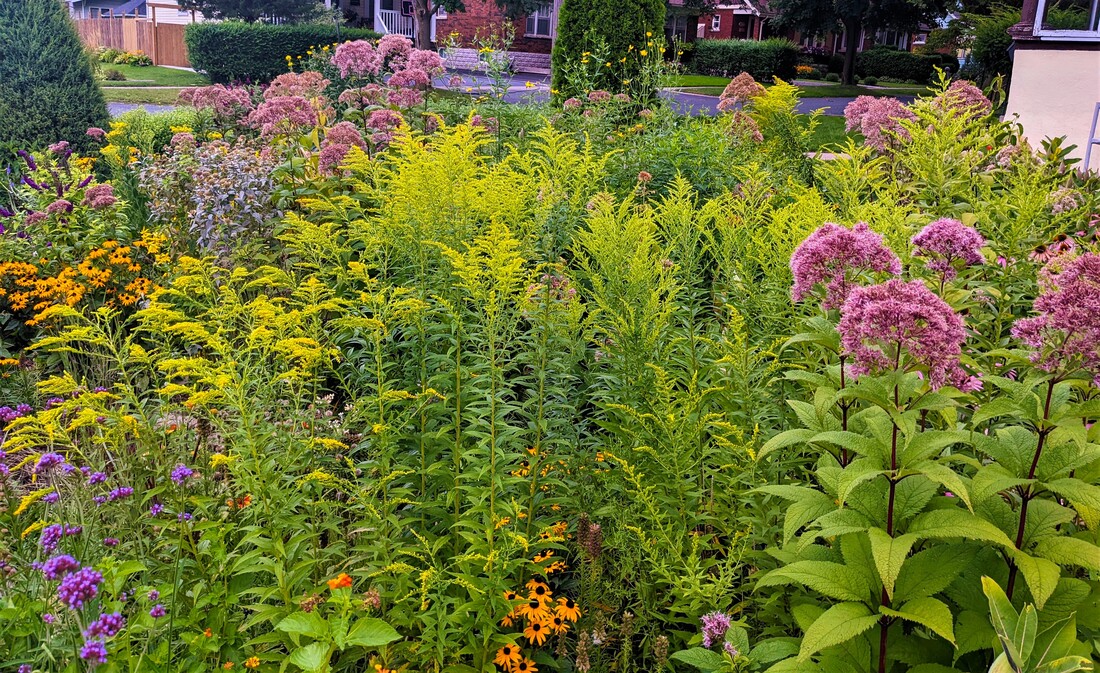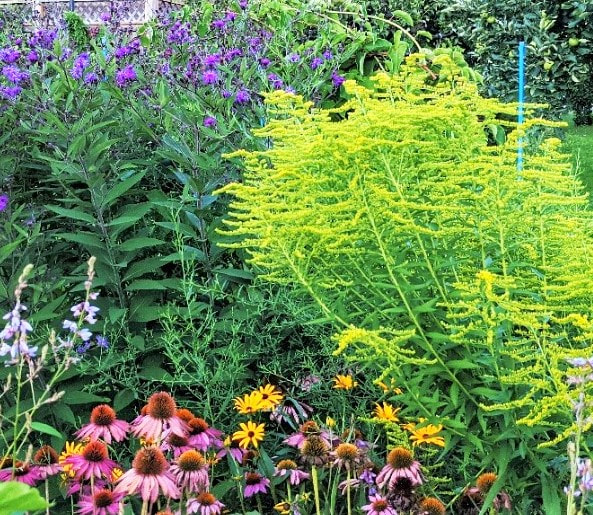|
Introduction Solidago Canadensis is my plant #24 in my native plant collection series. Solidago is solid – on any site where it is established as well as in the Latin translation of the word – "makes whole" – for its medicinal uses in indigenous traditions. Commonly called Canada Goldenrod it is one of about 25 Goldenrod species that are native to Ontario, all of which are oh so showy! And so bright. Powerful in beauty but also aggressive and prolific. Usually, the volunteer goldenrod that shows up in your garden and dares to show off its exuberant bright yellow blooms with no help at all is Canada goldenrod. C. goldenrod sees a garden and decides to come and take part in the party. It is up to the gardener weather or not she/he wants to allow it to stay. I welcome it because it has great value which I am about to discuss but I keep it up to a threshold. I will list some techniques in the “tips” section of this plant feature. Description In late summer it starts blooming on 4-5 feet tall stems. It sends out arching branches covered with tiny golden yellow flowers that create a panicle type bloom that looks like fireworks in structure and brightness. It is clump forming but also sends out rhizomatous roots that grow more stems all over the garden as well as it spreads from seeds so if not maintained it will colonize large areas. This vigour, as well as its height make it out-compete other plants. Wildlife value Dozens of bees and butterflies as well as flies and wasps will have a ball with it. C. goldenrod is very important to them. It provides them with lots of nectar and pollen as well as a pithy stem that makes a safe and cozy winter shelter for borrowing bees. I found out something amazing – over 40 species of moth caterpillars feed on its foliage! Birds feed the caterpillars to their babies and some birds eat the seeds too so this plant has huge value to wildlife. Growing conditions A perennial of unused grounds, abandoned field, roadsides, river banks, forest edges, savannas, in full sun to part shade. It will fill bare soil patches in the area where it arrives unless the area is water logged or absolutely completely dry. Although it is drought tolerant, the lower edges of the leaves will dry out and fall off during prolonged drought. Canada goldenrod tolerates poor to moderate soil as long as it drains well, in full sun to partial sun. Recommended planting situations are: Prairie or meadow garden, pollinator garden, wildflower garden, back margins or edges of a property. Companions: New England Aster (Symphyotrichum novae-angliae), Blue Wood Aster (symphyotricum cordifolium), Wild Geranium (Geranium maculatum), Indian grass (Sorghastrum nutans), Switch grass (Panicum virgatum), Big Bluestem (Andropogon gerardii), Giant Ironweed (Vernonia altissima), Woodland Sunflower (Helianthus divaricatus), Smooth Oxye (false sunflower: Heliopsis helianthoides), In my garden I have Ironweed growing beside Canada goldenrod in the food forest and Joe-Pye Weed with Canada goldenrod in my pollinator garden. I am trying to get more asters growing among it but they are currently not quite established yet. Tips
Goldenrods for gardens (that won’t take over and behave nicely):
I promised to share what is growing in my experimental garden collection: I have lots of Canada goldenrod that is entirely volunteer. I planted non of them. I started two varieties from seeds: Stiff goldenrod has established successfully in my front yard pollinator garden (see the descriptions in the photos I have shared). Grass-leaved goldenrod, which is quite an aggressive spreader, I took forever to decide where to plant it and I finally plopped it in the ground in fall and might move it in spring but I have confidence it will find its spot. The outcome of it is yet to be seen in my gardens so please let me know if you have any experiences with it.
That’s what I have for goldenrod. Make sure to do research about the kind of goldenrod you intend to plant. Whatever goldenrod you end up choosing, I’m confident it will be happy in your garden. Make sure you are too. Happy gardening!
0 Comments
Leave a Reply. |
Sharona GorenAvid gardener. Experimenter. Striver. Nature lover. Seeker. Archives
December 2022
Categories |
Site powered by Weebly. Managed by Netfirms
















 RSS Feed
RSS Feed